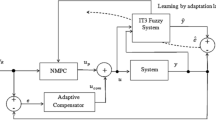Abstract
The paper presents computationally efficient predictive control approaches to stabilization of the blood glucose concentration in patients suffering from diabetes type 1. Presented algorithms use neural and fuzzy models and quadratic programming. These algorithms offer much better control performance than the algorithms based on linear models. Moreover, their closed–loop accuracy is similar to that obtained in predictive control algorithms with full nonlinear optimisation repeated on-line. Though simple, such algorithms offer advantages resulting from its prediction capabilities.
Access this chapter
Tax calculation will be finalised at checkout
Purchases are for personal use only
Preview
Unable to display preview. Download preview PDF.
Similar content being viewed by others
References
M. S. Bazaraa , J. Sherali, K. Shetty, Nonlinear programming: theory and algorithms. Prentice Hall, 1999.
M. Brdys, P. Tatjewski, Iterative Algorithms for Multilayer Optimizing Control, Imperial College Press, London, 2005.
E. F. Camacho, C. Bordons, Model Predictive Control. Springer, 1999.
D. W. Clarke, C. Mohtadi, P. S. Tuffs, “Generalized predictive control – I. The basic algorithm – I. The basic algorithm,” Automatica, vol. 23, pp. 137-148, 1987.
R. Cutler, B. Ramaker, “Dynamic matrix control – a computer control algorithm,” AIChE National Meeting, Houston, 1979.
S. Haykin, Neural networks – a comprehensive foundation. Prentice Hall. Englewood Cliffs, 1999.
K. Hornik, M. Stinchcombe, H. White, “Multilayer feedforward networks are universal approximators,” Neural Networks, vol. 2, pp. 359–366, 1989.
R. Hovorka, V. Canonico, L. J. Chassin, U. Haueter, M. Massi-Benedetti, M. Orsini Federici, T. R. Pieber, H. C. Schaller, L. Schaupp, T. Vering, M. E. Wilinska, “Nonlinear model predictive control of glucose concentration in subjects with type 1 diabetes,” Physiol Meas, vol. 25, pp. 905–920, 2004.
M. Ławryńczuk, P. Marusak, P. Tatjewski, “Cooperation of Model Predictive Control with steady-state economic optimisation,” Control and Cybernetics, vol. 37, 2008, pp.133–158.
M. Ławryńczuk, “A family of model predictive control algorithms with artificial neural networks,” International Journal of Applied Mathematics and Computer Science, vol. 17, pp. 217–232, 2007.
J. M. Maciejowski, Predictive Control with Constraints. Prentice Hall. Harlow, 2002.
P. Marusak, “Advantages of an Easy to Design Fuzzy Predictive Algorithm: Application to a Nonlinear Chemical Reactor,” Proc. Int. Multiconference on Computer Science and Information Technology, Wisla, Poland, 2007.
M. Morari, J. H. Lee, “Model predictive control: past, present and future,” Computers and Chemical Engineering, vol. 23, pp. 667-682, 1999.
A. Piegat, Fuzzy Modeling and Control. Physica–Verlag, Berlin, 2001.
S. J. Qin, T. A. Badgwell, “A survey of industrial model predictive control technology,” Control Engineering Practice, vol. 11, pp. 733-764, 2003.
D. Radomski, M. Ławryńczuk, P. Marusak, P. Tatjewski, “Modeling of glucose concentration dynamics for predictive control of insulin administration,” submitted to Biocybernetics and Biomedical Engineering.
J. A. Rossiter, Model-Based Predictive Control. CRC Press, Boca Raton. 2003.
T. Takagi, M. Sugeno, “Fuzzy identification of systems and its application to modeling and control,” IEEE Trans. on Systems, Man and Cybernetics, vol. 15, pp. 116–132, 1985.
P. Tatjewski, Advanced Control of Industrial Processes, Structures and Algorithms. Springer. London, 2007.
P. Tatjewski, M. Ławryńczuk, “Soft computing in model-based predictive control,” International Journal of Applied Mathematics and Computer Science, vol. 16, pp. 101-120, 2006.
Z. Trajanoski, “ Neural Predictive Controller for Insulin Delivery Using the Subcutaneous Route,” IEEE Transactions On Biomedical Engineering, vol. 45, pp. 1122-1134, 1998.
Author information
Authors and Affiliations
Corresponding author
Editor information
Editors and Affiliations
Rights and permissions
Copyright information
© 2010 Springer Science+Business Media B.V.
About this paper
Cite this paper
Ławryńczuk, M., Marusak, P.M., Tatjewski, P. (2010). Efficient Predictive Control Algorithms Based on Soft Computing Approaches: Application to Glucose Concentration Stabilization. In: Iskander, M., Kapila, V., Karim, M. (eds) Technological Developments in Education and Automation. Springer, Dordrecht. https://doi.org/10.1007/978-90-481-3656-8_77
Download citation
DOI: https://doi.org/10.1007/978-90-481-3656-8_77
Published:
Publisher Name: Springer, Dordrecht
Print ISBN: 978-90-481-3655-1
Online ISBN: 978-90-481-3656-8
eBook Packages: Humanities, Social Sciences and LawEducation (R0)




